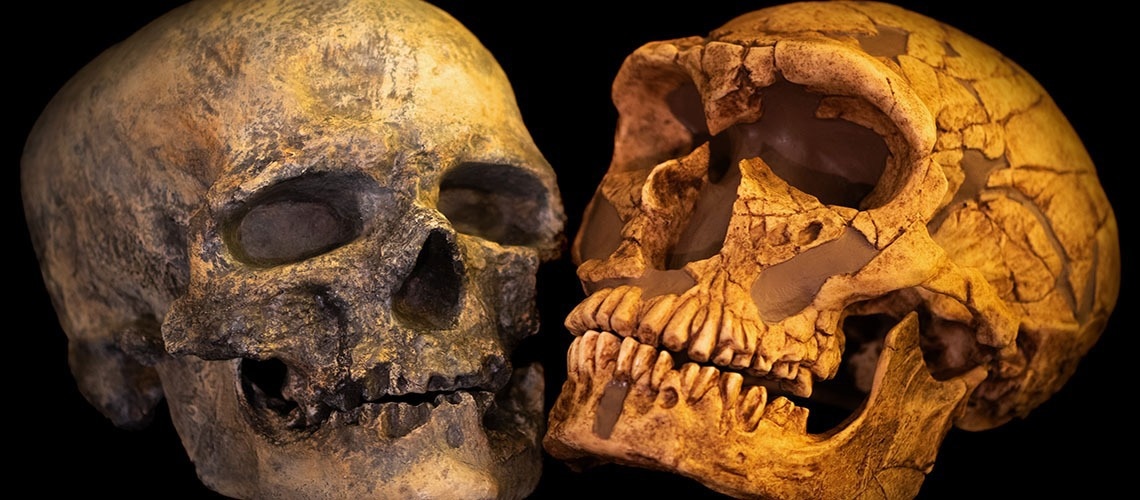Reviewed by Danielle Ellis, B.Sc.Oct 19 2023
Neanderthals, who had lived for hundreds of thousands of years on the western half of the Eurasian continent, gave way to Homo sapiens, who had come from Africa, some 40,000 years ago. This replacement was gradual, and the two species coexisted for millennia, culminating in the incorporation of Neanderthal DNA into the Sapiens genome.
 The UNIGE team analyzed the distribution of the portion of DNA inherited from Neanderthals in the genomes of humans (Homo sapiens) over the last 40,000 years. Image Credit: Claudio Quilodrán
The UNIGE team analyzed the distribution of the portion of DNA inherited from Neanderthals in the genomes of humans (Homo sapiens) over the last 40,000 years. Image Credit: Claudio Quilodrán
The distribution of the percentage of DNA acquired from Neanderthals in the (Homo sapiens) genomes during the last 40,000 years has been studied by researchers at the University of Geneva (UNIGE).
This statistical analysis showed minor differences in time and geographical location. This study, published in the journal Science Advances, contributes to the comprehension of the two species’ shared past.
It has been proved through genome sequencing and comparative analysis that Neanderthals and Sapiens interbred and that these encounters were sometimes productive, resulting in the presence of roughly 2% of Neanderthal DNA in modern Eurasians. This proportion fluctuates somewhat across Eurasia because DNA from Neanderthals is slightly more plentiful in Asian populations' genomes than in European populations.
One explanation for this disparity is that natural selection would not have had the same effect on Neanderthal genes in Asian and European populations. Another idea is being worked on by Mathias Currat’s team, senior lecturer in the Department of Genetics and Evolution at the UNIGE Faculty of Science.
Based on computer simulations, his previous work indicates that such variations could be clarified through migratory flows: when a migrant population hybridizes with a local population in their area of cohabitation, the proportion of DNA of the local population is prone to rise with distance from the migrant population's point of departure.
Europe: A Territory Shared by Both Species
In the case of Sapiens and Neanderthals, the idea is that the farther one gets away from Africa, Homo sapiens’ place of origin, the larger the fraction of DNA from Neanderthal, a group mostly found in Europe. To test this idea, the scientists examined a database made public by Harvard Medical School that contains over 4,000 genomes from people who lived in Eurasia during the last 40 millennia.
Our study is mainly focused on European populations since we are obviously dependent on the discovery of bones and the state of conservation of DNA. It turns out that archaeological excavations have been much more numerous in Europe, which greatly facilitates the study of the genomes of European populations.”
Claudio Quilodrán, Study Co-First Author, Senior Research and Teaching Assistant, Department of Genetics and Evolution, Faculty of Science, University of Geneva
Statistical investigations found that, following the spread of Homo sapiens from Africa, the genomes of Paleolithic hunter-gatherers living in Europe had a somewhat greater fraction of Neanderthal DNA than those living in Asia.
This finding contradicts current thinking but is consistent with paleontological facts, as the existence of Neanderthals has been documented mostly in western Eurasia (no Neanderthal bones have been located further east than the Altai area of Siberia).
The Arrival of Anatolian Farmers Modifies Genomes
As a result, the study reveals a decrease in the percentage of Neanderthal-originated DNA in European populations’ genomes during the Neolithic, or the shift from a hunter-gatherer to a farming lifestyle, 10,000–5,000 years ago. This percentage was then marginally lower than that of Asian populations (as currently observed).
The first farmers from Anatolia (the western peninsula of Turkey) and the Aegean region arrived in Europe around the same time that this decline occurred, and they too had less Neanderthal DNA than the European population at the time. The genomes of farmers from Anatolia “diluted” Neanderthal DNA a little bit more by mingling with European people.
The study demonstrates how several stages in the history of hybridized species can be traced using ancient genomic studies and archaeological evidence.
Source:
Journal reference:
Quilodrán, C. S., et al. (2023). Past human expansions shaped the spatial pattern of Neanderthal ancestry. Science Advances. doi.org/10.1126/sciadv.adg9817